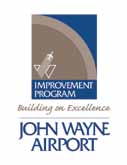
 In mid-November, airport director Alan Murphy opened the doors to the new $211.5 million Terminal C at John Wayne Airport (SNA) in Orange County, CA. The 282,000-square-foot, multi-level building includes six new commercial passenger gates, two commuter terminals, common-use technology for check-in and boarding, three baggage carousels, new security screening checkpoints and a variety of new concessions.
In mid-November, airport director Alan Murphy opened the doors to the new $211.5 million Terminal C at John Wayne Airport (SNA) in Orange County, CA. The 282,000-square-foot, multi-level building includes six new commercial passenger gates, two commuter terminals, common-use technology for check-in and boarding, three baggage carousels, new security screening checkpoints and a variety of new concessions.
As any airport director could attest, a capital improvement program of such proportions is the project of a lifetime. But in Murphy’s case, it’s part deux.
|
factsfigures Project: Passenger Terminal Airport: John Wayne Airport, Santa Ana, CA Size: 282,000 sq. ft. Estimated Cost: $211.5 million Funding: Airport revenues, general airport revenue bonds, passenger facility charge revenues & federal grants Annual Capacity: Up to 10.8 million passengers Program Manager: Parsons Architect/Engineer: Gensler Construction Manager: Arcadis (PinnacleOne) General Contractor: McCarthy Building Companies Baggage Handling System Design-Builder: Jervis B. Webb Concessions: CKE Restaurants, HMSHost, Caterina’s, Hudson Group, Paradies-OC, LLC Counters/Millwork: Fish Construction FIDS Displays: NEC Common-Use Passenger Processing System: Ultra Boarding Bridges: Jetway Systems, by JBT AeroTech |
“I have been able to hang on long enough to have the pleasure of being involved in our current program, which is a third terminal, as well as parking structures and a co-generation plant,” says Murphy.
which is a third terminal, as well as parking structures and a co-generation plant,” says Murphy.
“For me, personally, it is very exciting. A lot of times in this business you get the chance to do this once, and you learn a lot. But it is not very often that you have the opportunity to put those lessons learned into play. I am, frankly, enjoying it very much.”
The airport not only benefits from Murphy’s previous experience, but that of Gensler, the airport’s current architectural engineer, which also designed the original terminal back in 1990. Keith Thompson, Gensler’s aviation & transportation practice area leader, notes that he and Murphy are among a handful of professionals who participated in the original project that have returned to execute this follow-up building. Thompson was a planning consultant under contract with Gensler during the design of terminals A and B.
aviation & transportation practice area leader, notes that he and Murphy are among a handful of professionals who participated in the original project that have returned to execute this follow-up building. Thompson was a planning consultant under contract with Gensler during the design of terminals A and B.
The Parity Issue
“The design challenge was to have the new terminal achieve a sense of equality with terminals A and B,” says Thompson, noting that airport officials didn’t want to create a new terminal/old terminal dynamic. “Orange County wanted to create a new terminal that will be consistent with the original design. We took the concept plan we were given, and in pretty short order came up with a successful implementation of something that mimics terminals A and B for the most part, but at the same time creates a more modern experience.”
In Thompson’s opinion, the terminal’s most apparent and impressive space is the main vault – the large, arched space over the baggage claim area. On its face, he notes, it appears similar to terminals A and B, but it’s actually different in ways that are impressive in their own right. Unlike the diagonal trusses found in the original architecture, the Terminal C vault is upheld with Vierendeel trusses of rectangular panels and rigid joints.
“The Vierendeel trusses architecturally line up and complement the structural system in a way that is subtle, yet pronounced,” Thompson explains. “The vault itself is 15 feet larger in span than (the vault in) terminals A and B due to the nuances of working around the existing structure; but the end result is a much more open and impressive scale.”
Beyond the canopies that top the terminals, Murphy notes other similarities and differences between SNA’s two major improvement programs. The most recent initiative didn’t have the advantage of a greenfield site, he relates.

“We expanded a portion of the existing terminal and built an additional concourse facility, so we had the challenge of continuing to operate while under construction and mitigating the impacts on our passengers and tenants as much as we were able,” says Murphy. “For the most part, we were very successful in doing that.”
As program manager, Parsons worked to execute the project to the satisfaction of both the airport and the community. “Everything was visible to the public, and one of the key things was to make sure we operated first and constructed second,” recalls Parsons program manager, Danilo Simich.
airport and the community. “Everything was visible to the public, and one of the key things was to make sure we operated first and constructed second,” recalls Parsons program manager, Danilo Simich.
Transition Time
When terminals A and B were built back in the 1980s, the airport was on a separate site and required a complete transfer of operations. This time, the move-in wasn’t quite as complex.
“We went from a very small facility in the 1980s to a much larger facility in 1990, so that was quite a transition,” Murphy recalls. “Now, the transition is not quite as much for us. We have been operating these facilities for more than 20 years now, so as we make the transition into the new Terminal C, much of it is very familiar. We are a lot smarter, quite frankly.”

Designed to accommodate 8.4 million annual passengers, the Thomas F. Riley Terminal, which includes terminals A and B, has been serving nearly 9 million passengers annually in recent years. Recognizing the existing facility’s capacity bloat and the growing demands of the traveling public, the Orange County Board of Supervisors green-lighted the airport’s plans to expand.
Murphy considers SNA to be one of the most heavily regulated airports in the United States, if not the world. Litigation between the airport and community dating back to the mid-1980s was resolved with an agreement to cap passenger volume and operations as well as noise levels. “We renegotiated that agreement early in the last decade, and in order to implement that, we needed to build new facilities and new gates to fulfill that process,” explains Murphy.
“The environment has changed substantially,” he continues. “We went from 4.5 million passengers served in 1990 to nearly 10 million passengers now. And obviously, aviation in general has changed substantially since then as well.”
Such history prompted SNA to build in maximum flexibility to its new terminal. “We don’t know what the future is going to look like,” muses Murphy. “All we know is that it is going to change, and we want to make sure we can change with it as change occurs.”
Meeting Future Needs
With the opening of Terminal C, Murphy believes SNA is equipped to handle demand through the next 20 years, with enhancements to include additional opportunities for food/beverage and news/gift shops. Currently, the new terminal opens up on the end to a large marketplace where CKE Restaurants, Caterina’s and HMSHost are contracted to provide a variety of food/beverage options. Locally inspired stores operated by Hudson Group and The Paradies Shops feature a variety of regional and nationally branded merchandise.
In addition to updating concession trends, Murphy says the airport has taken advantage of the opportunity to be on the forefront of upcoming movements such as automation. SNA is the first U.S. airport to implement a Common-Use Passenger Processing System (CUPPS) throughout its terminal to improve the check-in and boarding processes for both passengers and air carriers, he notes.
As the new common-use system and a new flight information display system were installed in Terminal C, they were also installed in terminals A and B. “We were very conscious of the issue of not having an old versus new facility – both from our passengers’ as well as our tenants’ perspective,” says Murphy.
SNA also commissioned Jervis B. Webb to build new in-line baggage screening throughout the airport, so all three terminals will be in the same mode.
“Everything is going to look similar and have the same feel – that is updated, modern and 2011 versus 1990,” Murphy concludes.


